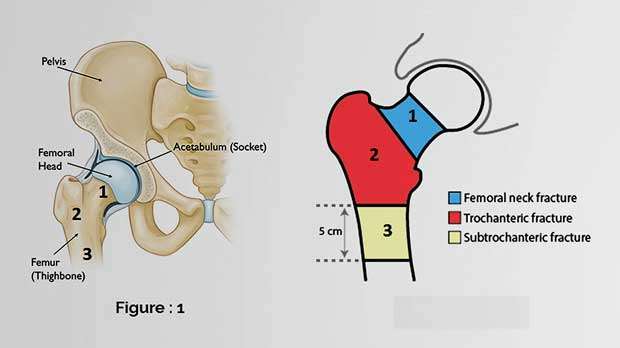09 Nov 2018 - {{hitsCtrl.values.hits}}

 Each lower limb is connected to the body via the hip joint which is very stable and socket type joint. It allows a vast range of movements. Each joint transfers half of the body weight when one stands upright. Talking about this part of the body, hip fractures are quite common in our present society. We spoke to Dr. Chandana Herath, Consultant Orthopaedic Surgeon, Base Hospital, Nuwara Eliya to shed light on the topic. Excerpts:
Each lower limb is connected to the body via the hip joint which is very stable and socket type joint. It allows a vast range of movements. Each joint transfers half of the body weight when one stands upright. Talking about this part of the body, hip fractures are quite common in our present society. We spoke to Dr. Chandana Herath, Consultant Orthopaedic Surgeon, Base Hospital, Nuwara Eliya to shed light on the topic. Excerpts:
Q Who are vulnerable to hip fractures ?
Hip fractures are commonly seen in the elderly women who have osteoporosis and is less common in men. The bone at the hip joint will be broken after a simple fall on one’s side. The peak incidents noted in the Sri Lankan population take place between the ages between 70-85 years.
QWhy are hip fractures commonly associated with the elderly ?
Fall prone bodily changes like poor vision, general slowness, prolonged reaction time and other medical conditions which interfere with balance and walking develop with advancing age. As I mentioned earlier, the weakened osteoporotic bone due to ageing is susceptible to fracture.
Q What exactly happens during a hip fracture?
There are many ways the hip can break and it ranges from two pieces to four pieces. The exact location of the fracture also matters when deciding the method of fixation. After examining the patient an orthopaedic surgeon will decide which method of treatment is suitable for a particular patient.
Patients who had half hip replacement would be off the bed next day morning and they are able walk with the full weight on the operated leg. We will recommend you to use a walking frame to ensure you do not fall again. The others who had plate and screw fixations are able to walk with a walking frame the next day. A patient will be advised as to how much weight must be applied on the operated leg.
Q How would you figured out if a person has a hip fracture?
A patient will find it difficult to stand up and put weight on the injured side. Pain will be felt at the groin when the leg is moved. The leg will appear short and turned outwards at the foot.
Q What could you do at home?
Make sure that the injured person is out of danger from further injuries and splint the leg to the uninjured leg. Two paracetamol tablets can be given to the patient until he is taken to the hospital. The patient can be in a seated position if pain-free. However, it is safer for the patient to be transported while lying flat. Make sure to take all available medical records and medications with the patient.
Q The procedure at the hospital ?
The patient will be examined and assessed by a doctor. A plain X - ray of the hip/Pelvis will be taken to identify the fracture.
Q What is the health impact of a hip fracture ?
The health of an elderly person can be deranged significantly and rapidly after sustaining a hip fracture. The elderly may look healthy as long as their bodies function undisturbed. Once this homeostasis is disturbed, recovery is slower. When the patients are bed bound with a hip injury, their heart activity, blood flow to parts of the body, respiration, bowel motions, hormonal regulations and brain function are subjected to change. Developing chest and urine infections is common in these patients and may worsen the condition. They are prone to develop bedsores rapidly and existing medical conditions like diabetes could go out of control despite regular medications.
Q How can these complications be prevented?
Surgical fixation of the hip joint is the reliable option available. The current recommendation by the National Institute for Health Care and Excellence (NICE) UK, is to have hip surgery approximately within 36-48 hours after the injury. Alternative treatment methods can not achieve a better outcome and the strong recommendation is to perform surgery without delay.
Q What are the benefits of the surgical treatment procedure?
The pain will be reduced immediately after the operation and there will be a marked relief. It will help in many ways since pain has deleterious effects on body physiology. So the derangement of the body organ systems will be reduced.
Q When can a patient walk again after hip surgery?
The patient can be mobilised easily i.e. can be allowed to sit, transfer from bed to chair. Nursing care could be given easily. A patient can stand up the following day after surgery and slowly return to normal activities.
Q What are the type of surgeries?
There are three main ways of fixing the broken bone. When the fracture is at the zone 1 (shown in picture), you will need a half hip joint replacement (Hemiarthroplasty). Total hip replacement will be done during certain instances. The fractures in the zone 2 are fixed with a plate and screws (Dynamic Hip Screw- DHS). Zone 3 fractures need fixation with a metal rod (Proximal femoral nail-PFN) inserted into the canal of the bone.
Q How long is the surgery?
It is a major surgery. However, it is a frequently performed simple surgery and will take about 45 minutes. The patient will be anesthetised to numb the lower limbs. Incision is made over the side of the hip about 4 inches. Immediately after fixing the hip the patient is allowed to eat and drink. One needs to remain in the hospital for 1-2 days after the operation. Medical problems like diabetes, high blood pressure, previous heart problems do matter with anaesthesia. However, medical conditions are optimised before surgery and modern day anesthesia is safe.
A patient will find it difficult to stand up and put weight on the injured side. Pain will be felt at the groin when the leg is moved. The leg will appear short and turned outwards at the foot
Q When can a patient return home after surgery ?
Generally, a patient can return home within 1-2 days. However, it may take additional 1 or 2 days if medical problems like diabetes are not under control.
Q What will happen if surgery is avoided?
If your fracture is in the zone 1 (Fig 1), never opt for healing without surgery because you may not be able to walk. Fractures in the zones 1 and 2 (Fig 1) might heal without a surgery. However, a patient has to remain in bed for eight to ten weeks without walking. After healing a patient will have difficulty in walking, squatting and wearing trousers.
If surgery is not done the fractured leg will be painful up to one month. In addition, there is a high chance of developing complications like bed sores, pneumonia, blood clots in the calves and lungs etc. The chance of losing life is high within the 1st year after injury if surgery is not done. Further, the leg could be shortening and awkwardly healed. A patient will never be able to walk normally again. Sometimes, it may not heal at all and then would require an operation later. In such cases the operation will be difficult and the injury may get complicated.
Q How about wound care?
The wound will be checked before being discharged from the hospital. The wound heals within 7-10 days. Having a shower after one week is not a problem and the wound should be kept dry following a bath.
Patients will be screened to detect other medical conditions like checking for eye sight and controlling osteoporosis which could prevent further falls.
22 Dec 2024 24 minute ago
22 Dec 2024 45 minute ago
22 Dec 2024 47 minute ago
22 Dec 2024 6 hours ago
22 Dec 2024 7 hours ago